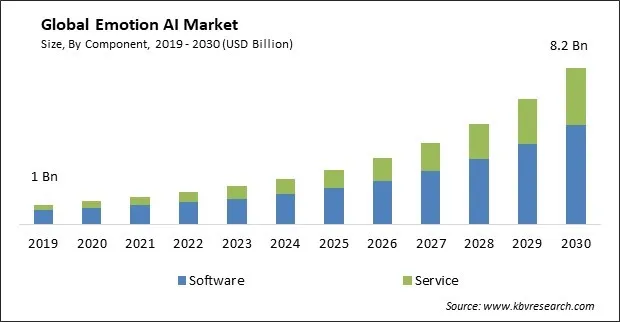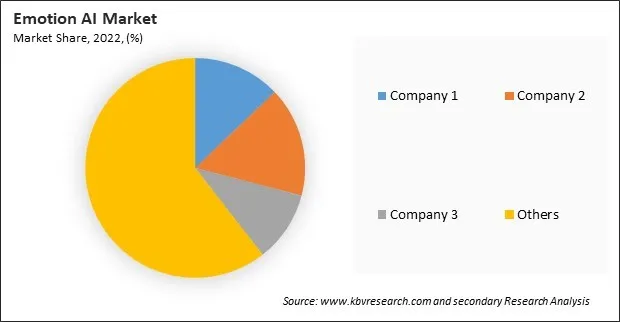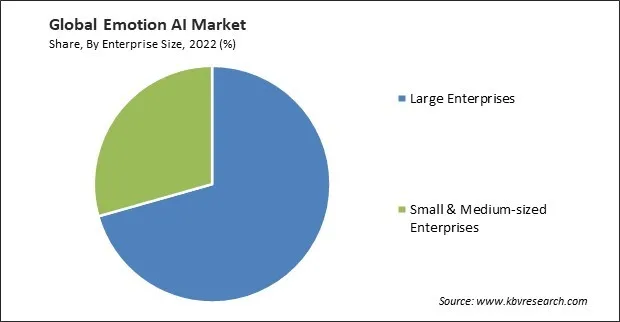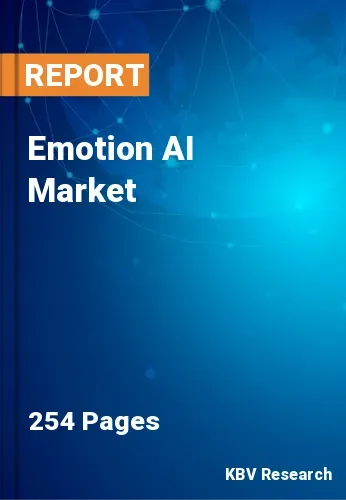The Global Emotion AI Market size is expected to reach $8.2 billion by 2030, rising at a market growth of 22.3% CAGR during the forecast period.
Emotion AI can continuously monitor patients' emotional states, helping in the early detection of emotional distress and providing timely interventions. It analyzes patient feedback and sentiments to identify areas for advancement in healthcare services, facilities, and communication. Therefore, the healthcare segment will capture 6.9% share in the market by 2030. This can be integrated into telehealth solutions to gauge the emotional well-being of remote patients, especially those dealing with chronic conditions or mental health issues. It can be integrated into therapy applications to provide real-time patient and therapist feedback during remote counseling sessions. Some of the factors impacting the market are rapid advancements in AI technology, increasing use in healthcare and mental health support, and lack of standardization.

Progress in sensor technologies, natural language processing, computer vision, and emotion recognition techniques have expanded the capabilities and accuracy of emotion AI. Developing machine learning techniques, such as deep learning and neural networks, which allow for more accurate emotion recognition and analysis from multiple data sources, enhances it. Additionally, The healthcare industry uses it for applications related to mental health, patient engagement, and remote monitoring, contributing to better patient outcomes. This is used to continuously monitor the emotional states of individuals, especially those with mental health conditions. It provides valuable insights for healthcare professionals to tailor treatment plans. This, in turn, contributes to the growth of the market.
However, the absence of industry standards for emotion AI can lead to inconsistency in developing, evaluating, and deploying emotion recognition systems. The absence of standardized guidelines or best practices can lead to inconsistency in how these models are developed. Companies and researchers may use varying methodologies and data sources, challenging comparing, and benchmarking solutions. Without standardized evaluation protocols, assessing the performance of these systems can be challenging. Thus, the lack of standardization in the market is a significant challenge that affects the development, evaluation, and deployment of emotion recognition systems.

The leading players in the market are competing with diverse innovative offerings to remain competitive in the market. The above illustration shows the percentage of revenue shared by some of the leading companies in the market. The leading players of the market are adopting various strategies in order to cater demand coming from the different industries. The key developmental strategies in the market are Acquisitions, and Partnerships & Collaborations.
By component, the market is categorized into software and service. In 2022, the software segment held the highest revenue share in the market. The market includes a variety of software solutions designed to recognize, interpret, and respond to human emotions and sentiments. These software applications analyze human emotions using natural language processing, machine learning, and computer vision. This software recognizes and interprets emotions in various forms, such as facial expressions, voice tone, and text. It is used in applications ranging from customer service to mental health support.
Based on enterprise size, the market is classified into large enterprises and small & medium-sized enterprises. The small and medium-sized enterprises segment acquired a substantial revenue share in the market in 2022. Emotion AI enables SMEs to understand and respond to customer emotions more effectively. This can lead to more personalized and empathetic interactions, fostering customer loyalty and positive word-of-mouth. It can monitor employee engagement and emotional well-being, particularly relevant for SMEs aiming to create supportive work environments.

On the basis of vertical, the market is divided into BFSI, healthcare, IT & telecom, retail & e-commerce, government & defense, media & entertainment, automotive, and others. In 2022, the retail and e-commerce segment dominated the market with maximum revenue share. Emotion AI is used to understand and respond to customer emotions, allowing for personalized shopping experiences and product recommendations. Retailers use it to analyze customer emotions in physical stores, helping to optimize store layouts and product placements for better engagement. Retailers gather emotional customer feedback about their products, which inform product development and merchandising strategies.
| Report Attribute | Details |
|---|---|
| Market size value in 2022 | USD 1.7 Billion |
| Market size forecast in 2030 | USD 8.2 Billion |
| Base Year | 2022 |
| Historical Period | 2019 to 2021 |
| Forecast Period | 2023 to 2030 |
| Revenue Growth Rate | CAGR of 22.3% from 2023 to 2030 |
| Number of Pages | 254 |
| Number of Table | 380 |
| Report coverage | Market Trends, Revenue Estimation and Forecast, Segmentation Analysis, Regional and Country Breakdown, Market Share Analysis, Companies Strategic Developments, Company Profiling |
| Segments covered | Component, Enterprise Size, Vertical, Region |
| Country scope | US, Canada, Mexico, Germany, UK, France, Russia, Spain, Italy, China, Japan, India, South Korea, Singapore, Malaysia, Brazil, Argentina, UAE, Saudi Arabia, South Africa, Nigeria |
| Growth Drivers |
|
| Restraints |
|
Region-wise, the market is analyzed across North America, Europe, Asia Pacific, and LAMEA. In 2022, the North America region led the market by generating the highest revenue share. The North American market is one of the largest and is expected to continue growing. The United States plays a pivotal role in the market's growth. North America has seen strong adoption of Emotion AI across various industries, including healthcare, retail, media, finance, and technology. The technology is used for customer engagement, employee well-being, and content personalization.
Free Valuable Insights: Global Emotion AI Market size to reach USD 8.2 Billion by 2030
The market research report covers the analysis of key stake holders of the market. Key companies profiled in the report include IBM Corporation, Microsoft Corporation, Cogito Corporation, Eyeris Technologies, Inc., Apple, Inc., Smart Eye A/S (Affectiva, Inc.), NuraLogix Corporation, Realeyes OU, NVISO SA, and Emotibot Technologies Limited.
By Component
By Enterprise Size
By Vertical
By Geography


This Market size is expected to reach $8.2 billion by 2030.
Rapid Advancements in AI Technology are driving the Market in coming years, however, Lack Of Standardization restraints the growth of the Market.
IBM Corporation, Microsoft Corporation, Cogito Corporation, Eyeris Technologies, Inc., Apple, Inc., Smart Eye A/S (Affectiva, Inc.), NuraLogix Corporation, Realeyes OU, NVISO SA, and Emotibot Technologies Limited.
The expected CAGR of this Market is 22.3% from 2023 to 2030.
The Large Enterprises segment is registering maximum revenue in the Market, By Enterprise Size in 2022, achieving a market value of $5.5 billion by 2030.
The North America region is generating the highest revenue in the Market, By Region in 2022, and would continue to be a dominant market till 2030; thereby, achieving a market value of $3.1 billion by 2030.
Our team of dedicated experts can provide you with attractive expansion opportunities for your business.

